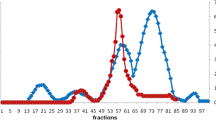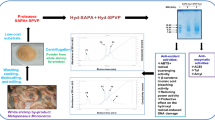Abstract
This study aimed to assess the antioxidant potential of Chlorella vulgaris protein-derived enzymatic hydrolysate using Caenorhabditis elegans. Protein extraction was performed using an alkali solution after complete C. vulgaris swelling and hydrolysis using four commercial proteases (alcalase, neutrase, protamex, and flavourzyme). The results showed that the flavourzyme hydrolysates exhibited the strongest antioxidant activity both in vitro and in vivo. Under the optimum conditions of the enzymatic hydrolysis, the half-maximal effective concentration of the hydrolysates for superoxide and hydroxyl radicals was 0.323 mg/mL and 0.139 mg/mL, respectively. The hydrolysates could significantly extend the lifespan, improve the resistance to methyl viologen-induced oxidative stress, reduce the levels of reactive oxygen species, and enhance the activity of catalase and superoxide dismutase in C. elegans.







Similar content being viewed by others
References
Sies, H., & Jones, D. P. (2020). Reactive oxygen species (ROS) as pleiotropic physiological signalling agents. Nature Reviews Molecular Cell Biology, 21, 363–383.
Kaludercic, N., & Di Lisa, F. (2020). Mitochondrial ROS formation in the pathogenesis of diabetic cardiomyopathy. Frontiers in Cardiovascular Medicine, 7, 12.
Liguori, I., Russo, G., Curcio, F., Bulli, G., Aran, L., Della-Morte, D., Gargiulo, G., Testa, G., Cacciatore, F., & Bonaduce, D. (2018). Oxidative stress, aging, and diseases. Clinical Interventions in Aging, 13, 757.
Ballal, A., Chakravarty, D., Bihani, S. C., & Banerjee, M. (2020). Gazing into the remarkable world of non-heme catalases through the window of the cyanobacterial Mn-catalase ‘KatB.’ Free Radical Biology and Medicine, 160, 480–487.
Agregán, R., Munekata, P. E., Franco, D., Carballo, J., Barba, F. J., & Lorenzo, J. M. (2018). Antioxidant potential of extracts obtained from macro-(Ascophyllum nodosum, Fucus vesiculosus and Bifurcaria bifurcata) and micro-algae (Chlorella vulgaris and Spirulina platensis) assisted by ultrasound. Medicines, 5, 33.
Wong, F.-C., Xiao, J., Wang, S., Ee, K.-Y., & Chai, T.-T. (2020). Advances on the antioxidant peptides from edible plant sources. Trends in Food Science & Technology, 99, 44–57.
Elias, R. J., Kellerby, S. S., & Decker, E. A. (2008). Antioxidant activity of proteins and peptides. Critical Reviews in Food Science and Nutrition, 48, 430–441.
Qian, Z.-J., Jung, W.-K., Byun, H.-G., & Kim, S.-K. (2008). Protective effect of an antioxidative peptide purified from gastrointestinal digests of oyster, Crassostrea gigas against free radical induced DNA damage. Bioresource Technology, 99, 3365–3371.
Ru, I. T. K., Sung, Y. Y., Jusoh, M., Wahid, M. E. A., & Nagappan, T. (2020). Chlorella vulgaris: A perspective on its potential for combining high biomass with high value bioproducts. Applied Phycology, 1, 2–11.
Ko, S.-C., Kim, D., & Jeon, Y.-J. (2012). Protective effect of a novel antioxidative peptide purified from a marine Chlorella ellipsoidea protein against free radical-induced oxidative stress. Food and Chemical Toxicology, 50, 2294–2302.
Sheih, I.-C., Wu, T.-K., & Fang, T. J. (2009). Antioxidant properties of a new antioxidative peptide from algae protein waste hydrolysate in different oxidation systems. Bioresource Technology, 100, 3419–3425.
Shuang, W., Gaofan, Z., Xinyue, C., Wenting, Z., Weimin, W., & Yongjun, Z. (2017). Preparation of Chlorella protein and the antioxidant effect of the hydrolyzed peptides. Journal of Chinese Institute of Food Science and Technology, 17, 92–100.
Lowry, O. H., Rosebrough, N. J., Farr, A. L., & Randall, R. J. (1951). Protein measurement with the Folin phenol reagent. Journal of Biological Chemistry, 193, 265–275.
D’Alessandro, E. B., & Antoniosi Filho, N. R. (2016). Concepts and studies on lipid and pigments of microalgae: A review. Renewable and Sustainable Energy Reviews, 58, 832–841.
Hildebrand, G., Poojary, M. M., O’Donnell, C., Lund, M. N., Garcia-Vaquero, M., & Tiwari, B. K. (2020). Ultrasound-assisted processing of Chlorella vulgaris for enhanced protein extraction. Journal of Applied Phycology, 32, 1709–1718.
Xu, S., Zhang, Y., & Jiang, K. (2016). Antioxidant activity in vitro and in vivo of the polysaccharides from different varieties of Auricularia auricula. Food & Function, 7, 3868–3879.
de Albuquerque Wanderley, M. C., Neto, J. M. W. D., de Andrade, A. F., de Melo, R. G., de Araújo Viana-Marques, D., Bezerra, R. P., & Porto, A. L. F. (2020). First report on Chlorella vulgaris collagenase production and purification by aqueous two-phase system. Sustainable Chemistry and Pharmacy, 15, 100202.
Molino, A., Iovine, A., Casella, P., Mehariya, S., Chianese, S., Cerbone, A., Rimauro, J., & Musmarra, D. (2018). Microalgae characterization for consolidated and new application in human food, animal feed and nutraceuticals. International Journal of Environmental Research and Public Health, 15, 2436.
Zhang, G. (2015). Research of hypoglycemic activity of antioxidant peptide from Chlorella vulgaris (in Chinese). Master’s thesis, China Jiliang University, China.
Wang, W., Chen, Z., & Yao, H. (2002). Extracting rice protein with different proteases. Cereal & Feed Industry, 2, 41–42.
Halliwell, B. (1978). Superoxide-dependent formation of hydroxyl radicals in the presence of iron chelates: Is it a mechanism for hydroxyl radical production in biochemical systems? FEBS Letters, 92, 321–326.
Zečić, A., & Braeckman, B. P. (2020). DAF-16/FoxO in Caenorhabditis elegans and its role in metabolic remodeling. Cells, 9, 109.
Abdul, H. M., Sultana, R., Clair, D. K. S., Markesbery, W. R., & Butterfield, D. A. (2008). Oxidative damage in brain from human mutant APP/PS-1 double knock-in mice as a function of age. Free Radical Biology and Medicine, 45, 1420–1425.
Srinivas, U. S., Tan, B. W., Vellayappan, B. A., & Jeyasekharan, A. D. (2019). ROS and the DNA damage response in cancer. Redox Biology, 25, 101084.
Yu, M. (2020). Preparation of proteins from Chlorella vulgaris and the effect on oxidative stress and glucose metabolism (in Chinese). Master’s thesis, China Jiliang University, China.
Safi, C., Zebib, B., Merah, O., Pontalier, P.-Y., & Vaca-Garcia, C. (2014). Morphology, composition, production, processing and applications of Chlorella vulgaris: A review. Renewable and Sustainable Energy Reviews, 35, 265–278.
Acknowledgements
This work was supported by National Science and Technology Program during the Twelfth Five-year Plan Period (No. 2013BAD10B02).
Author information
Authors and Affiliations
Corresponding author
Ethics declarations
Conflict of interest
The authors declare that there are no conflicts of interest associated with this manuscript.
Additional information
Publisher's Note
Springer Nature remains neutral with regard to jurisdictional claims in published maps and institutional affiliations.
Rights and permissions
About this article
Cite this article
Zhang, Y., Jiang, W., Hao, X. et al. Preparation of the Enzymatic Hydrolysates from Chlorella vulgaris Protein and Assessment of Their Antioxidant Potential Using Caenorhabditis elegans. Mol Biotechnol 63, 1040–1048 (2021). https://doi.org/10.1007/s12033-021-00361-4
Received:
Accepted:
Published:
Issue Date:
DOI: https://doi.org/10.1007/s12033-021-00361-4




